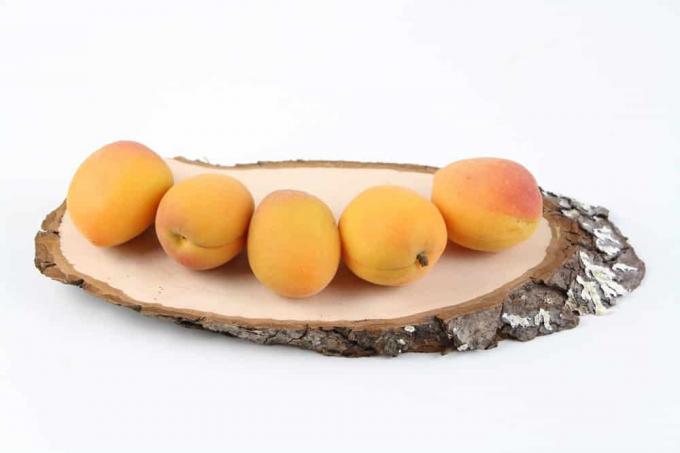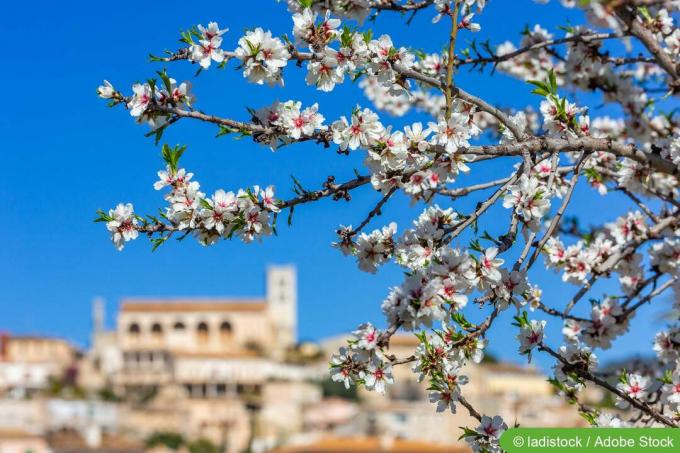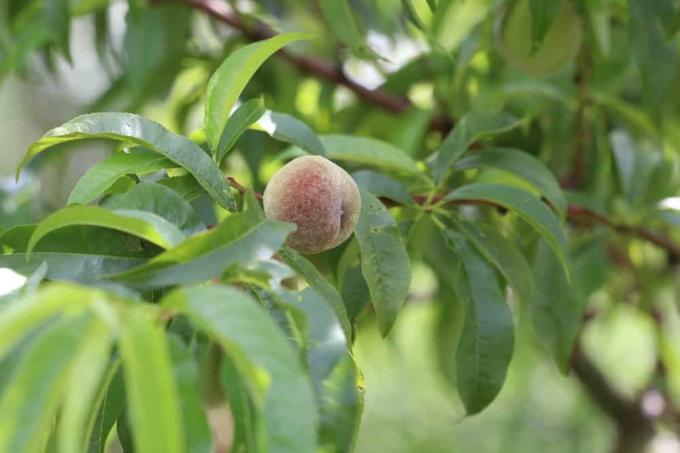

Table of contents
- grow apricot trees
- Varieties from A to Z
- Particularly recommended varieties
- dwarf fruit trees
- Conclusion
Apricot trees are sometimes a bit difficult. Depending on the variety, a frost or various diseases can quickly spoil a reasonable harvest. With apricots, the ideal location and the most resistant varieties possible are even more important than with other fruit trees. And of course the right care. In order to make things as easy as possible from the start, you should lay the right foundations when you buy the tree.
grow apricot trees
Two factors are particularly important when growing apricot trees - the selected variety and the location. If you do everything right here, not too much stands in the way of a good harvest. A wrong choice, on the other hand, can lead to considerable disappointment at the latest when harvesting. First, let's look at the location. Apricots love it warm and sunny. A location in full sun is therefore a must. It should also be protected from wind and to some extent from rain, as the flowers and fruits are very sensitive to strong gusts of wind and heavy rain. A sunny spot in the immediate vicinity of a house wall is ideal. It should be noted that the tree needs a total area of around eight square meters in order to be able to develop freely. The soil should be as nutrient-rich as possible. A moderately stony loess or clay soil that also has a high humus content is perfect. Do you have such a location or If this soil is not available, the cultivation of an apricot tree is basically possible, but you should then be prepared for rather low yields.
Tip:
When planting the young tree in the root area, mix the existing soil well with leaf or bark compost. This increases the humus content enormously.
Varieties from A to Z
For a long time, apricot trees had a shadowy existence in our gardens and were hardly in demand. That has now changed fundamentally. More and more hobby gardeners are discovering the apricot as an attractive fruit for their garden. So it is not surprising that the trade is also reacting to the increased demand. There you can now find a relatively large selection of varieties, all of which are in principle suitable for cultivation in our latitudes. The most common are:
- Ambrosia: medium-sized, very juicy fruit
- Compacta: juicy, medium-sized fruit
- Gold Rich: Extremely sweet, aromatic and rather small fruit
- Hargrand: rather sour and medium-sized fruit
- Harlayne: juicy, small to medium-sized fruit
- Kyoto: aromatic, firm, medium-sized fruit
- Kuresia: very aromatic, sweet, slightly sour fruit
- Luizet: very juicy and very sweet medium-sized fruit
- Mino: sweet, juicy, medium-sized fruit
- Mombacher Frühe: very juicy, not quite as sweet, medium-sized fruit
- Nancy: sweet, large fruit
- Orangered: juicy, sweet, firm and very large fruit
- Prunus armeniaca: sweet and rather small fruit (dwarf fruit trees)
- Shipleys Blenheim: juicy, very aromatic, medium-sized fruit
- Temporao de Villa Franca: juicy, sweet and sour, firm fruit of medium size
- Uhlhorn's miracle apricot: very juicy, aromatic, medium-sized fruit
- Hungarian Best: sweet, slightly sour, medium-sized fruit
- True early apricot: very aromatic and large fruits
- Dwarf Column Gold Fire: sweet, juicy, small fruits (dwarf fruit trees)
Particularly recommended varieties

The varieties listed above are basically suitable for cultivation under the climatic conditions that mostly prevail in our country. However, they differ enormously in terms of susceptibility to diseases and pests, their sensitivity to cold and their yield. If you really want to be on the safe side, the following varieties are particularly recommended:
- compacta, which has a compact, rather weak growth, but is resistant to frost
- gold rich (also spelled Goldrich): Extremely easy to care for, robust, resistant to almost all diseases that can affect apricot trees, frost hardy, late harvest
- Hargrand, also very resistant, insensitive, high yield
- Harlayne, robust and above all extremely productive
- Kuresia, also very robust, frost hardy and the only variety that is also resistant to Sharka disease
- Kyoto, very hardy, with an exceptionally strong growth
- Luizet: robust, resistant, also copes well with rather harsh climatic conditions
As a hobby gardener, you really can’t go wrong with these three varieties. Last but not least, they are characterized by the fact that they have proven to be extremely robust in the face of diseases. It is important to know that apricot trees are generally very susceptible to bacteria, viruses and fungi. These usually enter the plant through injuries to the tree. Therefore, in addition to a sheltered location, careful, careful pruning is also recommended.
dwarf fruit trees
What applies to conventional apricot trees also applies to a very special degree to dwarf fruit trees or columnar apricots. Even with the popular mini variant, the location and the plant substrate must be right. If you want to cultivate the trees in a planter, you should also make sure that this has a volume of at least 30 liters. In addition, waterlogging must not occur under any circumstances when watering. Among the dwarf fruit trees, these two apricot varieties are particularly recommended:
- gold rich (Goldrich) as a dwarf fruit tree with similar properties to its big brother
- Golden Sun as a columnar apricot, the fruit of which, however, should only be eaten fresh or processed immediately
- Rosina, which are perfect for cultivation in a bucket or suitable for the planter
Dwarf fruit trees require significantly more attention and care than conventional fruit trees. In addition to constant watering, fertilization plays a major role. Only compost should be used as fertilizer. On the other hand, work is saved when pruning trees. In the case of dwarf fruit trees, this is significantly lower. However, one should be aware that the yields of these tiny plants are also limited. The fruits are often much sweeter and more aromatic. And to avoid any misunderstandings: dwarf fruit trees can be cultivated on the terrace or on the balcony, but are not suitable as indoor plants.
Conclusion
Apricot trees have long been considered distinctly mimosa-like. The reasons for this were, on the one hand, their high susceptibility to diseases and, on the other hand, their sensitivity to cold temperatures. Above all, extremely low temperatures could very quickly put an end to many varieties. Luckily, that has changed to a certain extent. With frost-hardy varieties, such as those mentioned above, the dreaded late frosts in spring no longer pose a major problem. However, it is important that these special varieties also have a generally warm, sunny location. Even if they can withstand a frosty night or two, they still need higher temperatures to really thrive and be able to carry a rich harvest. Last but not least, the sun also plays a major role in the aroma and sweetness of the fruit. If you want to plant an apricot tree in your garden, you should definitely focus on a frost-hardy, robust variety and the right location.
 garden editorial
garden editorial I write about everything that interests me in my garden.
Learn more about fruit trees

Life on Mallorca: highlight almond blossom
Life on Mallorca offers a lot more than sun, summer, beach and Ballermann. The beginning of the year on the popular holiday island is all about blossoming almond trees. We'll tell you when and where you can best enjoy the almond blossom on Mallorca.

Cutting sour cherries: 21 tips for the right cut
In order for a sour cherry to remain productive year after year, it must be pruned regularly. Wood that has been removed must be removed and new fruit wood must be promoted. This only works if the "editor" knows the editing rules.

Is the ornamental peach edible? | 15 tips for care and cutting
The ornamental peach can be a decorative addition to the garden as early as March, when the trees, which are up to three meters high, are in bloom. Here we tell you how to look after them and whether their fruits are edible.

20 old apple varieties | List of old apples in & around Germany
Hardly any type of fruit is as diverse as the apple. The number of apple varieties worldwide is estimated at over 20,000. Old apple varieties are those that were discovered before 1950. We have compiled a list of popular, old varieties for you.

Peach Tree Diseases: Leaves curl or turn yellow
Among the fruit trees, the peach tree is one of the most susceptible to diseases. It often has to contend with fungal diseases such as curling disease. Here you can find out which other tree diseases can affect it, how to recognize them and how to fight them successfully.

Half-trunk cherry and apple trees: planting distance and care
Fruit trees definitely belong in every garden. But what to do if the garden is too small for a large tree? Then trees that were grown as half-stems can help. They take up less space, but deliver lots of fruit. More about this here.



